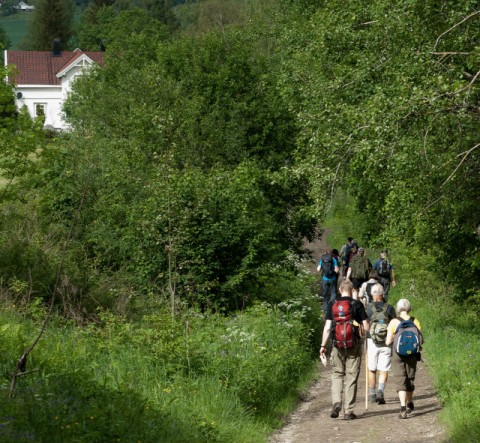Restored pilgrim paths

In 1944, the legendary director Michael Powell made the film A Canterbury Tale, now recognized as one of the greatest and most beloved classics of British cinema. This strange fantasy depicts a group of conflicted modern people on a dreamlike trip to the city of Canterbury, following in the footsteps of the medieval precursors who pioneered the route still known as the Pilgrims’ Way. However secular their intentions when they first set out, each in his or her way finds at Canterbury the answer to long-felt hopes and dreams.
In the 1940s, Powell’s vision was hopelessly romantic. Yes, millions of Catholic and Orthodox believers still went on pilgrimages to such shrines as Lourdes, Fátima, and Santiago de Compostela, and revived English sites like Walsingham attracted hard-core Anglo-Catholics. In the modern Protestant world, though, pilgrimage was clearly seen as a relic of bygone eras.
Read our latest issue or browse back issues.
But over the past generation, that institution has experienced a startling revival across what we often dismiss as secular Europe. As I described in an earlier column (“Pilgrims of our times,” May 18, 2010), many older shrines have been revived and attract millions of younger seekers, and whole new pilgrim destinations have been added to the map.
One sign of the widespread interest in older sacred landscapes is the renewed popularity of ancient pilgrim pathways, which in their day were scarcely less important than the great shrines to which they ultimately led. Before the Reformation, everyone knew the routes that led to centers like Compostela, roads marked by hostels and inns, where believers could obtain souvenirs and pilgrim passports. Largely in the present century, the identification and revival of such long-forgotten pilgrim trails has been a major endeavor for religious believers no less than secular tourist authorities. Pilgrimage tourism has become very big business.
The revival grows partly out of the renewed interest in Compostela and the elaborate trail systems of the Way of St. James, traversing southern France and northern Spain. Today, that route has been extended into Switzerland and even the northern Netherlands. Newly inspired pilgrims then demanded the restoration of other ancient trails, such as the 1,300-mile Via Francigena leading from Canterbury to Rome.
That interest in turn provoked local initiatives in most European countries, where tourist maps now abound with serpentine trails spanning hundreds of miles. In Great Britain, St. Cuthbert’s Way unites the shrines of medieval northern England. You can walk across North Wales, taking the healing waters at St. Winefride’s Well and continuing to the holy island sanctuary at Bardsey. Cornwall’s Saints’ Way was recognized anew only in the late 1980s. The faster the church attendance figures drop, the more rapidly have shiny new markers appeared along the restored pilgrim trails.
One singularly unlikely example of such a revival comes from Protestant Norway. Although Norwegians are commonly baptized into the Lutheran national church, religious attendance and participation have declined sharply, and the country looks like a classic example of Scandinavian secularism. But it was not always so, and the medieval church had its beloved saints, above all Olaf, a fierce warrior who perished in battle in 1030. The cathedral of Nidaros was built over his remains, in what became the modern city of Trondheim. In its day, Nidaros was a far northern counterpart to Santiago, that other center for the veneration of a mighty Christian warrior, James the Moor-Slayer.
As at Santiago itself, a wide-ranging network of roads once led pilgrims to Nidaros. Those pathways fell out of use at the Reformation, but since the late 1990s they have once more been marked out, and they are much used. The main branch of St. Olav’s Way—the Pilegrimsleden—runs some 400 miles from Oslo, but you can join it from other centers in Norway, Sweden, and Denmark. The whole network includes 3,000 miles of Scandinavian trails. Also within the past decade or so, state-supported pilgrim centers and hostels have reappeared along the way. (The trail’s website is at http://pilegrimsleden.no/en/.)
Are modern travelers along St. Olav’s Way pilgrims in any meaningful sense or simply hikers and outdoor explorers with a taste for a spectacular and varied northern landscape? Certainly, the official publicity associated with the route speaks to secular audiences as well as religious. But it also stresses the “inner journey” and “mental transformation” that visitors can expect. As any reader of Chaucer’s Canterbury Tales knows, travelers along the pilgrim ways have always been fired by diverse motives, sacred and profane, worthy and otherwise. When was there ever a sharp division between tourism and religious seeking?
Within a short span of time, European countries have once more mapped out the contours of a sacred landscape spanning much of the continent and defined it in historic Christian terms.







